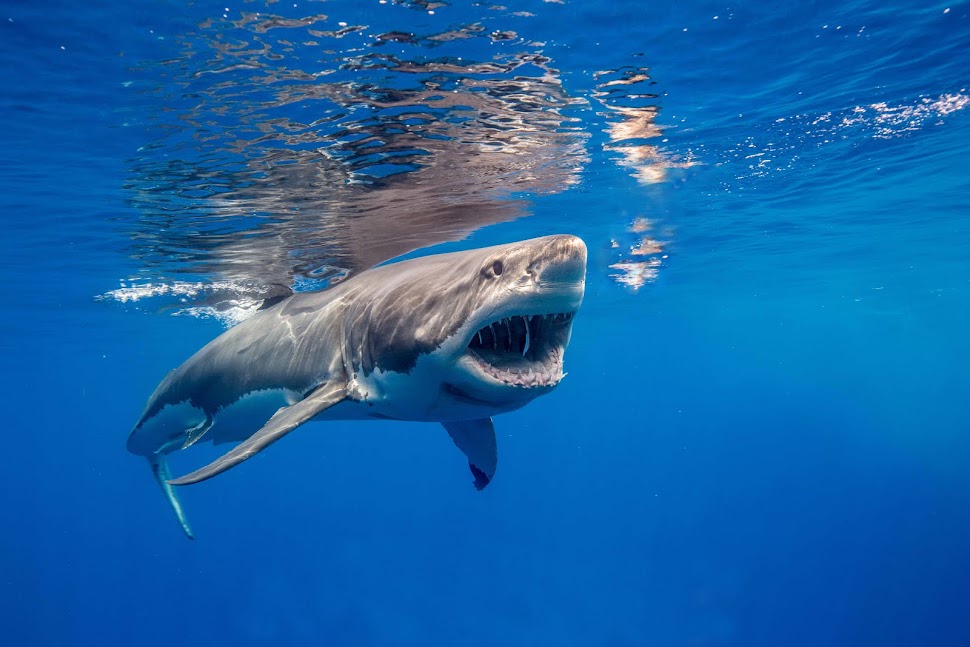
There's only a few places in the world where divers-who are crazy-can get face to face with Great White sharks with the added safety of a cage. For many in the scuba world and beyond these critters are the pinnacle underwater thrill, a close encounter with the "Man in the Grey Suit". You may want to even consider the "Grand-Tour", a visit to each shark site in under one year. For many shark divers this remains the Holy Grail of shark diving.
Be sure to save up in advance as the total cost with flights, hotels, tips, and a few beers for the fearless shark gals in South Africa will set you back about $30,000. If you put it all on Visa they may even stick you in a commercial..Priceless!
Top Three White Shark Encounters:
Neptune Islands-Australia Neptune Islands provide an ideal habitat for great white sharks. Great whites like rocky outcrops and volcanic islands because the shear drop-offs around the edges of the islands into cool, deep water provides the sharks with the temperature and depth that they need, while the seals and other animals that live on the islands provide an easily accessible food source. Neptune Islands sit on a submarine shelf south east of Port Lincoln, and provide an ideal habitat for these ambush predators. This small group of rocky islands, composed of grey granite and coastal loam, supports a large colony of seals as well as a colony of endangered Australian sea lions. Underwater footage for the movie "Jaws" was shot here because the waters around these islands are a natural feeding area for great whites. They have become one of the single best great white dive destinations in the world.
Who Dives There: Rodney Fox
Dyer Island- South Africa Six miles off of Gansbaai, off the Western Cape of South Africa, lies Dyer Island. This is the original white shark destination and the granddaddy of them all. These low, rocky islands serve as a breeding ground for a wide variety of seabirds, while it's neighbour, a rocky outcrop called Geyser Islet, serves as a home for a large resident seal population. Put those two together and what you have is a prime time wildlife buffet for the great white sharks. White sharks, especially juveniles but also a few adults, are seen on a regular basis in the channel between the two islands where they feed on a variety of seals, often leaping completely out of the water "Air Jaws" style. This natural feeding ground is the main reason that many divers consider South Africa to be the one of the world's top shark diving destinations. With it's unique combination of wreck, reef, tropical and sub-tropical diving, this prime natural hunting ground for great whites, has earned South Africa a reputation as "the shark diving capital of the world"
Who Dives There: Apex Predators
Isla de Guadalupe-Mexico
Guadalupe Island is an oceanic, volcanic island about 190 miles offshore of Baja Mexico, 210 miles south of San Diego. The island has a sheer rock wall extending hundreds of feet up into the air, as well as hundreds of feet into the ocean. Great whites like rocky outcrops and volcanic islands because the shear drop-offs around the edges of the islands into cool, deep water provides the sharks with the temperature and depth that they need, while the seals and other animals that live on the islands provide an easily accessible food source. The volcanic islands are the only known reproductive zone for the Guadalupe fur seal in the world, and are important reproductive zones for a number of other marine animals as well. Recently discovered in 2001 by "Doc" Anes from San Diego Shark Diving- the islands large population of pinnipeds makes it one of the world's top places for great white shark sightings bar none.
Who Dives There: Shark Diver


No comments:
Post a Comment